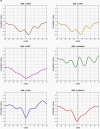Peatland groundwater level in the Indonesian maritime continent as an alert for El Niño and moderate positive Indian Ocean dipole events
- PMID: 36653400
- PMCID: PMC9849340
- DOI: 10.1038/s41598-023-27393-x
Peatland groundwater level in the Indonesian maritime continent as an alert for El Niño and moderate positive Indian Ocean dipole events
Abstract
In general, it is known that extreme climatic conditions such as El Niño and positive Indian Ocean Dipole (IOD+) cause prolonged drought in Indonesia's tropical peatlands so that groundwater levels (GWL) drop and peat is prone to fire. However, 27 years of GWL measurements in Central Kalimantan peat forests show the opposite condition, where the lowest GWL occurs several weeks before El Niño and after IOD+ reaches its peaks. We show that the dropped sea surface temperature anomaly induced by anomalously easterly winds along the southern Java-Sumatra occurs several weeks before the GWL drop to the lowest value. Local rainfall decreased, and GWL dropped sharply by 1.0 to 1.5 m, during the super El Niño events in 1997/98 and 2015, as well as remarkable events of IOD+ in 2019. It is suggested that the tropical peatland ecohydrological system (represented by the GWL), El Niño Southern Oscillation (ENSO), and IOD+ are teleconnected. Hence, monitoring GWL variability of peatland over the IMC is a possibility an alert for extreme climate events associated with El Niño and/or moderate IOD+.
© 2023. The Author(s).
Conflict of interest statement
The authors declare no competing interests.
Figures








References
-
- Aldrian E, Susanto RD. Identification of three dominant rainfall regions within Indonesia and their relationship to sea surface temperature. Int. J. Climatol. 2003;23:1435–1452. doi: 10.1002/joc.950. - DOI
-
- Susanto RD, Wei Z, et al. Oceanography surrounding Krakatau Volcano in the Sunda Strait, Indonesia. Oceanography. 2016;29(2):228–237. doi: 10.5670/oceanog.2016.31. - DOI
-
- Bryden HL, Imawaki S. Ocean transport of heat. In: Siedler G, Church J, Gould J, editors. Ocean Circulation and Climate. Academic Press; 2001. pp. 455–475.
-
- Sprintall J, Gordon AL, Koch-Larrouy A, Lee T, Potemra JT, Pujiana K, Wijffels S. The Indonesian Seas and their role in the coupled ocean-climate system. Nat. Geosci. 2014;7:487–492. doi: 10.1038/ngeo2188. - DOI
MeSH terms
Substances
LinkOut - more resources
Full Text Sources

